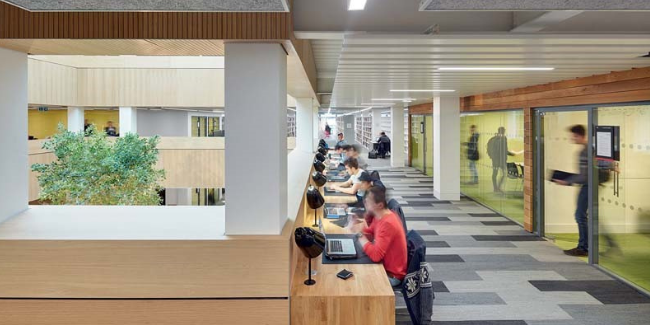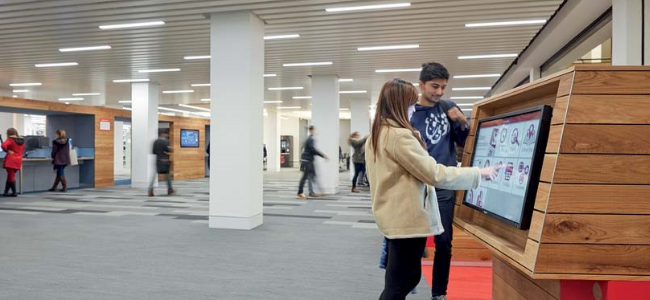
By Rob Mackinlay, Senior Reporter, Information Professional
21 April 2022
Lancaster University Library’s immersion in technology has enabled it to work on cutting-edge, cross-campus IT projects.
In this Q&A, Thomas Shaw, Assistant Director for Digital Innovation and Research Services, explains and explores the potential and pitfalls of HE library technology.
What is your role at the university?
I oversee two key areas at Lancaster University Library: our use of digital technology, and our services that facilitate academic research. Having a portfolio that incorporates digital as a leading component allows us to be innovative
and creative in the way we use technology, to be at the forefront of digital innovation across the sector and to maximise impact and value for our users. We have played a significant role in the leadership and ¬delivery of the university’s
Lancaster Digital 2.0 strategy, and are a key partner in future strategic planning around digital, including in areas outside of the
‘traditional’ library sphere.
"Having a portfolio that incorporates digital as a leading component allows us to be innovative and creative in the way we use technology."
Key to our success is the ‘special relationship’ we have with Information Systems Services (ISS), the University’s IT department. We place top priority on managing and cultivating this relationship, working in a way which is as open and
collaborative as possible.
We also benefit significantly from having a small Digital Innovation team embedded within the Library. This micro development team provide advanced technical skills at the heart of our library service. They have a deep understanding of
the needs of our users, and work seamlessly with library staff from other teams to deliver technical services that maximise the value of our investment in library systems. The team are not merely an ‘IT department in the Library’ or
a library systems team, but are a unique and customised resource, reflecting the seismic and revolutionary impact that technology has had on libraries over the past two decades.
Our approach to digital ensures that we are strategically engaged across the institution. This has provided opportunities for us to embrace the ‘service provider, partner, leader’ model, outlined in SCONUL’s 2017 report Mapping the future of academic libraries.
Our digital services remain core and deliver significant value to our users, but we also increasingly work as partners with others across the institution, and in certain areas we lead the strategic direction and activity.
What LMS and other digital products do you already have?
The heart of our digital ecosystem is Ex Libris’s Alma, which delivers our core library functions. We use Ex Libris’s ¬Primo discovery layer and Leganto resource list system to power our OneSearch and Resource Lists services. Additionally,
as an institution we use Ex Libris’s Campus M to power our university app, iLancaster. We are heavily reliant on Ex Libris, which some may perceive as being ‘in too deep’ with a single vendor, or having ‘all our eggs in one basket’.
Although we are conscious of the risk of vendor lock-in, we see advantages here too: being a major customer makes us a greater stakeholder. We judge each requirement for a system on its merits, and the most appropriate product for
us may not always be from Ex Libris. But we see value in being a significant customer, with the greater heft and influence that brings.
In addition to Ex Libris we are major users of SpringShare products, and rely increasingly on LibCal, LibAnswers, LibChat and LibGuides. These products were invaluable for responding to the pandemic. We rapidly introduced LibChat to allow
users to live chat with library staff, which complemented our existing email enquiry services via LibAnswers, and allowed us to swiftly respond to the closure of the physical library space and the need to deliver services digitally.
Our Ex Libris and SpringShare products are integrated into a wider portfolio of services, and using Ex Libris’s APIs we have created an integrated digital ecosystem. We have developed digital services from scratch to plug into existing
systems and fill niches and bespoke needs that off the shelf commercial products don’t meet. For instance, in 2019 we developed a content ordering system that integrates with Alma and other systems including the university’s user ¬management
systems and the Copyright Licensing Agency’s Digital Content Store. This provides a single front door for all library users to request new content and an admin interface and workflow for content team staff to fulfill requests via the
most appropriate and cost-effective route.
Could you give any examples of projects you are doing that show how you use library technology?
Our approach to digital has provided opportunities to work beyond the ¬traditional parameters of the Library. For instance, we were a major stakeholder in a project in 2018/19 to design Ask L.U., Lancaster University’s voice and chat service for students.
Using Amazon’s Alexa technology, and accessible via an Amazon Echo smart speaker, smartphone or tablet, Ask L.U. allows students to access a wealth of university information using their voice. We were significant partners in this project
in two ways:
- Providing expertise on using Amazon technologies, based on our experience of working with Amazon’s AWS cloud services.
- Designing and delivering integrations with library systems. For instance, students can use Ask L.U. to find out what books they have on loan or book a group study room in the library, via integrations with Alma and LibCal.
In other areas, we are working with stakeholders across the institution to lead an initiative to increase the value and impact of special collections and visual outputs from academic research. We have partnered with Cambridge University
to develop and implement an instance of their Cambridge University Digital Library platform, which follows Manchester’s launch of Manchester Digital Collections in 2019. Our own Lancaster Digital Collections will host high quality
images and multimedia content from our archives and special collections and from partnerships with others, including our academic researchers.
In other areas, we are working with stakeholders across the institution to lead an initiative to increase the value and impact of special collections and visual outputs from academic research. We have partnered with Cambridge University
to develop and implement an instance of their Cambridge University Digital Library platform, which follows Manchester’s launch of Manchester Digital Collections in 2019. Our own Lancaster Digital Collections will host high quality
images and multimedia content from our archives and special collections and from partnerships with others, including our academic researchers.
How are you managing and using data?
As a library we have developed plans to make greater use of the data held within our LMS and other sources to drive evidence-based decision making. We already use Alma Analytics reporting functionality, and through the recent formation
of two new staff groups within the Library we will be expanding its use and maximising its value. As with many libraries, we have historically been very good at capturing data but perhaps less good at realising the latent value in
the broad range of data sources and exploring how to use it to make better decisions.
We are also using technology to develop new data-driven services in Research Intelligence. Tools such as Scopus, SciVal and Altmetric have enabled us to help researchers explore the impact of their research through analysing citations
and other activity around academic publications. We’re beginning to push this use of citation data further, via a current piece of work to explore the relationship between research grant income and publication and citation of research
papers. And we have future plans to explore ways of automating much of this data reporting, ensuring that relevant users have access to data on tap at the point of need.
What is the biggest challenge for technology now?
The need for flexibility from vendors and their systems is critical. No single vendor will be able to provide everything a modern academic library service needs, and those needs change with increasing frequency. Interoperability with other
systems, and the ability to reconfigure and adapt systems, is critically important:
- Ability to configure systems differently according to business needs. The business needs should power the design and configuration of the system, not the reverse. For instance, we have recently repurposed functionality in Alma to create
pick lists for a book delivery service for students who are self-isolating. This type of flexibility will be increasingly important in meeting future needs for rapid service design.
- Access to APIs for bespoke development. The ability to build upon existing systems through data transfer to other systems and bespoke developments is increasingly important. For instance, our students are able to see information from
Alma, such as loan information, in the student portal. This mirrors the approach taken by Gov.uk web services, where users don’t need to understand the organisational structure in order to access a service.

What are the next big challenges for the sector?
As the academic library landscape continues to change rapidly, it is essential that systems keep pace and can underpin these changes. In recent years, services within scholarly communications, particularly open access and research data
management, have moved centre stage for libraries. And the development of transformative agreements driven by Plan S is creating closer synergy between open access workflows and content/subscription workflows. It is essential that
vendors work with these changes, as Ex Libris has sought to do with the development of their Esploro platform. But the added presence of current research -information (CRIS) systems (e.g. Pure, Symplectic, Converis, Worktribe) introduces
a future with potentially greater flux and competition, with both CRIS vendors and library system vendors increasingly operating within the same space.
Library systems will also need to encompass the library’s growing role as content creator and publisher. This is already well established from the perspective of institutional open access repositories, and has been accelerated by the open
access requirements for REF 2021. But repositories are still relatively siloed from other library systems, and there is an opportunity for greater integration. Additionally, library systems will need to develop into areas such as research
data, and support the growing needs of researchers to find, work with and cite datasets as well as publications. And academic libraries will increasingly need infrastructure to support institutional publishing and hosting of monographs,
particularly given the likely requirements of UKRI’s forthcoming revised open access policy.
Conclusion: How do you see vendors helping?
Vendors need to appreciate that this is a varied landscape and not all libraries are identical. In many respects we are in a privileged position at Lancaster in having a great depth of technical expertise in house. Working in other institutions
I’ve also experienced the challenge of having no technical staff resource within the library, and having to compete with a myriad of other priorities in the IT department. Vendors need to accommodate the ability for bespoke development
by customers themselves, but also offer off the shelf, flexible, customisable solutions, configurable without in depth technical knowledge, for those who can’t undertake their own technical development. The pandemic has demonstrated
the extent to which user and business needs can change instantaneously, and libraries (and the systems that underpin their services) need to be able to respond rapidly.
In addition, it is undoubtedly an understatement to say that current financial circumstances are challenging. Almost every library will be under significant pressure to save money. It would be a rare library that is able to abandon its
LMS to save costs, so it remains a major overhead in terms of budgets. It is more important than ever for vendors to deliver fair and transparent pricing, including clarity about the rationale for any annual price increases. And vendors
must ensure that their systems can facilitate the rapid and agile development of services demanded by the pandemic. It is crucial that every financial commitment pays its way and delivers impact and value.
Originally published in CILIP's Annual Directory 2021 Buyers' Guide.
Book your free place at CILIP's Supplier Showcase on 12 May in London.





